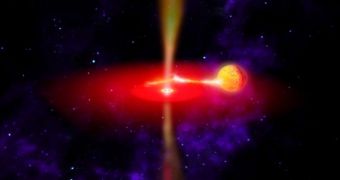In a large batch of data provided by the NASA Wide-field Infrared Survey Explorer (WISE) spacecraft, a team of astronomers recently discovered amazing new data on the flaring black hole GX 339-4. The findings could lead to a better understanding of the blazing jets these powerful objects produce.
The flaring black hole is located relatively close to our solar system, at a distance of only 20,000 light-years, towards the center of the Milky Way. In its entirety, our galaxy spans more than 120,000 light-years in diameter, astronomers explain.
One of the main reasons astronomers and astrophysicists are so interested in studying the highly-energetic jet released by such structures is that these formations reveal more data on the extremely chaotic environments surrounding the dark behemoths.
The jets are produced from material that falls through the event horizon from a structure called the accretion disk. Black holes do not gulp up matter directly, but rather accrete it into this disk, from which a constant flow of matter is consumed at all times.
Through studies conducted with radio, gamma-ray and X-ray telescopes, experts were able to collect impressive amounts of data about these emissions themselves. However, the brightest parts of the jets are still very poorly understood, as they are located at their very base.
With the help of its remarkable, sensitive infrared detectors, WISE was able to provide the necessary missing link in the observations. The black hole that made its target is relatively small, tipping the scale at only 6 solar masses.
“Imagine what it would be like if our Sun were to undergo sudden, random bursts, becoming three times brighter in a matter of hours and then fading back again. That's the kind of fury we observed in this jet,” Poshak Gandhi explains.
“With WISE's infrared vision, we were able to zoom in on the inner regions near the base of the stellar-mass black hole's jet for the first time and observe the physics of jets in action,” adds the expert, who holds an appointment as a research scientist with the Japan Aerospace Exploration Agency (JAXA).
He is also the lead author of a new study detailing the findings, which is published in the latest issue of the esteemed Astrophysical Journal Letters. “To see bright flaring activity from a black hole, you need to be looking at the right place at the right time,” Peter Eisenhardt goes on to say.
“WISE snapped sensitive infrared pictures every 11 seconds for a year, covering the whole sky, allowing it to catch this rare event,” ads the investigator, who is a WISE project scientist based at the NASA Jet Propulsion Laboratory (JPL), in Pasadena, California.
The most remarkable discovery WISE enabled was that the jet activity itself appeared to display huge and erratic fluctuations over very small time scales, of between 11 seconds and couple of hours.

 14 DAY TRIAL //
14 DAY TRIAL //